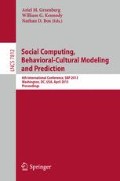Abstract
We introduce the Networked Resource Game, a graphical game where players’ actions are a set of resources that they can apply over links in a graph to form partnerships that yield rewards. This introduces a new constraint on actions over multiple links. We investigate several network formation algorithms and find bilateral coalition-proof equilibria for these games. We analyze the outcomes in terms of social welfare and inequality, as measured by the Gini coefficient, and show how graph formation affects these aspects of a networked economy.
Access this chapter
Tax calculation will be finalised at checkout
Purchases are for personal use only
Preview
Unable to display preview. Download preview PDF.
References
Albert, R., Barabasi, A.-L.: Statistical mechanics of complex networks. Reviews of Modern Physics 74, 47–97 (2002)
Axelrod, R., Hamilton, W.D.: The evolution of cooperation. Science 211, 1390–1396 (1981)
Duong, Q., Vorobeychik, Y., Singh, S., Wellman, M.P.: Learning graphical game models. In: IJCAI (2011)
Elkind, E., Goldberg, L., Goldberg, P.: Nash equilibria in graphical games on trees revisited. In: Proceedings of the 7th ACM Conference on Electronic Commerce, pp. 100–109. ACM (2006)
Gini, C.: On the measure of concentration with special reference to income and statistics. Colorado College Publication (1936)
Groh, G., Lehmann, A., Reimers, J., Friess, M., Schwarz, L.: Detecting social situations from interaction geometry. In: 2010 IEEE Second International Conference on Social Computing (SocialCom), pp. 1–8 (August 2010)
Heckerman, D., Geiger, D., Chickering, D.M.: Learning bayesian networks: The combination of knowledge and statistical data. In: Machine Learning, pp. 197–243 (1995)
Hsieh, H.-P., Li, C.-T.: Mining temporal subgraph patterns in heterogeneous information networks. In: 2010 IEEE Second International Conference on Social Computing (SocialCom), pp. 282–287 (August 2010)
Kearns, M., Littman, M., Singh, S.: Graphical models for game theory. In: Conference on Uncertainty in Artificial Intelligence, pp. 253–260 (2001)
Kim, E., Chi, L., Maheswaran, R., Chang, Y.-H.: Dynamics of behavior in a network game. In: IEEE International Conference on Social Computation (2011)
Luo, L., Chakraborty, N., Sycara, K.: Prisoner’s dilemma in graphs with heterogeneous agents. In: 2010 IEEE Second International Conference on Social Computing (SocialCom), pp. 145–152 (August 2010)
Ortiz, L., Kearns, M.: Nash propagation for loopy graphical games. In: Neural Information Processing Systems (2003)
Erdös, P., Rényi, A.: On random graphs. i. Publicationes Mathematicae 6, 290–297 (1959)
Qiu, B., Ivanova, K., Yen, J., Liu, P.: Behavior evolution and event-driven growth dynamics in social networks. In: 2010 IEEE Second International Conference on Social Computing (SocialCom), pp. 217–224 (August 2010)
Vickrey, D., Koller, D.: Multi-agent algorithms for solving graphical games. In: National Conference on Artificial Intelligence, AAAI (2002)
Yitzhaki, S.: More than a dozen alternative ways of spelling gini economic inequality. Economic Inequality (1998)
Author information
Authors and Affiliations
Editor information
Editors and Affiliations
Rights and permissions
Copyright information
© 2013 Springer-Verlag Berlin Heidelberg
About this paper
Cite this paper
Li, Z., Chang, YH., Maheswaran, R. (2013). Graph Formation Effects on Social Welfare and Inequality in a Networked Resource Game. In: Greenberg, A.M., Kennedy, W.G., Bos, N.D. (eds) Social Computing, Behavioral-Cultural Modeling and Prediction. SBP 2013. Lecture Notes in Computer Science, vol 7812. Springer, Berlin, Heidelberg. https://doi.org/10.1007/978-3-642-37210-0_24
Download citation
DOI: https://doi.org/10.1007/978-3-642-37210-0_24
Publisher Name: Springer, Berlin, Heidelberg
Print ISBN: 978-3-642-37209-4
Online ISBN: 978-3-642-37210-0
eBook Packages: Computer ScienceComputer Science (R0)

